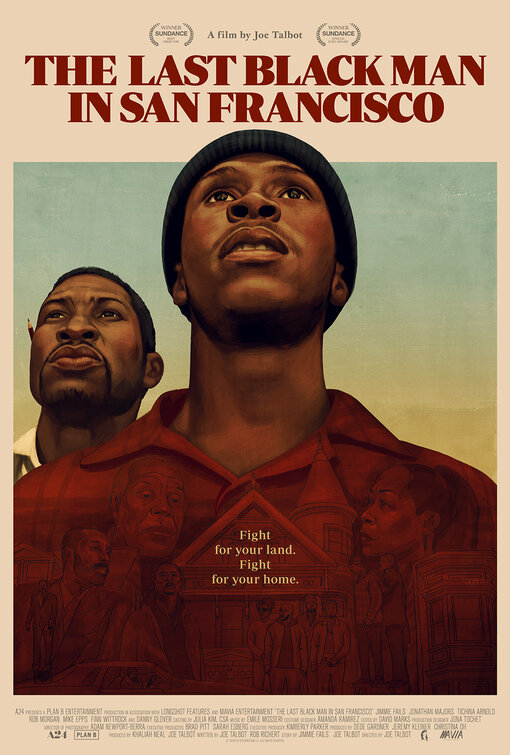
![]() The way a booming tech industry can negatively affect the changing Bay Area landscape fuels the art of some really great films. Just a year after 2018 gave us both Blindspotting and Sorry to Bother You, we have The Last Black Man in San Francisco – another story that mines the subject of gentrification in “The City by the Bay”. To call it a story is a bit imprecise, however. This is not a plot-heavy drama but merely an elegiac reflection with a wistful nod towards creating a mood. It washes over you like an emotional embrace with a love for a city that is slowly morphing into a much different community. Dorothy once proclaimed “There’s no place like home” in The Wizard of Oz. This movie most assuredly asserts that expression.
The way a booming tech industry can negatively affect the changing Bay Area landscape fuels the art of some really great films. Just a year after 2018 gave us both Blindspotting and Sorry to Bother You, we have The Last Black Man in San Francisco – another story that mines the subject of gentrification in “The City by the Bay”. To call it a story is a bit imprecise, however. This is not a plot-heavy drama but merely an elegiac reflection with a wistful nod towards creating a mood. It washes over you like an emotional embrace with a love for a city that is slowly morphing into a much different community. Dorothy once proclaimed “There’s no place like home” in The Wizard of Oz. This movie most assuredly asserts that expression.
This is the feature-length debut from filmmaker Joe Talbot, a fifth-generation San Franciscan, who directs his longtime friend in the lead role. Jimmy Fails is an S.F. native who plays a fictionalized version of himself. Fails and writer Rob Richert collaborated on the script with Talbot. This is a fully realized work from a director and star who have deeply experienced this lamentation. The tech industry has been both a boon and bane to a population. At the very least, it has created a vast income disparity. In turn, this has propelled S.F. to be the most absurdly expensive real estate in the entire U.S. Only the richest 1% can afford. Fact: according to the Cost of Living Index, The median home price is $1.6 million in S.F. and the average rent for an apartment is $3,821 a month. That has had an effect on businesses too. Places like La Victoria, a historic Mexican bakery in the Mission, had to shut down after 70 years in business in 2018. In Joe Talbot’s words, this is rapidly altering the very fabric of a city which is pushing out “some of the people who made San Francisco so great.”
At the center of the account is a tender relationship between Jimmie and his idiosyncratic best friend Montgomery (Jonathan Majors). They ride skateboards and wear thrift store duds. Their rapport is not unlike the bond between two much younger boys. They’re uncommonly close. Jimmie currently lives with his buddy in the tiny house of Montgomery’s blind father (Danny Glover) in the city’s Bayview neighborhood. It’s here on the streets that Jimmie and Montgomery are taunted for their close bond by tough outspoken locals credited as the “Greek Chorus”. These two close friends struggle in the outskirts of the city in which they can no longer afford to live. The vulnerable pair are united by a quest to find their place in an area that seems to have left them behind.
Jimmie still obsesses over the elegant Victorian home his grandfather built in the now-gentrified Fillmore District – a section once nicknamed “Harlem of the West.” His unending drive to reclaim his childhood abode drives this narrative. The ornate edifice with its stained-glass windows, wood-paneling, and witch’s hat turret—is a character in itself. The estate’s current value has made his birthplace financially out of his reach. Various vignettes clarify his mindset on a San Francisco odyssey. Tichina Arnold pops up as Jimmie’s aunt and Rob Morgan appears as his father, Jimmie Fails Sr. One poignant moment occurs on a public transit bus where he casually bumps into his own mother, whom he hasn’t seen in some time. She’s played by Jimmie’s actual mother in real life.
The Last Black Man in San Francisco doesn’t overtly promote an agenda. It’s far more subtle than that. This is a deeply felt contemplation that appeals on a purely sentimental level. The film’s lack of a narrative thrust may irk some. Indeed at times, I wished for a little more momentum. This feels like a funeral that honors the past with a profound love that pines for a bygone era. Cinematographer Adam Newport-Berra presents a languid tribute to a forgotten age. The images beautifully underscored by a majestic score by composer Emile Mosseri making his feature debut.
This quirky city once comprised a cultural diversity that included bohemians, musicians, artists, and other counterculture dreamers. In recent years the metropolis has morphed into a playground for hipster transplants with six-figure salaries. Yes, I acknowledge I’m simplifying a community that still remains remarkably diverse. However, a key scene has our protagonist, Jimmie on a Muni bus when he overhears two young women dissing the place that he treasures – “I’ve been saying for months, let’s just move to East L.A.,” one woman says to the other. “This city is dead.” In a moment of clarity Jimmie directly addresses her point blank: “You don’t get to hate San Francisco. You don’t get to hate it unless you love it.”. The declaration spews from lips with a passion that got me choked up. Perhaps because I call the Bay Area my home, this rumination really struck a chord with me. It clearly comes from an emotional place, so I hope anyone can appreciate the depth of the meditation. This is a movie that comes from the heart.
06-14-19

6 Responses
Very insightful review. I want to see this despite me being on the opposite side of the country. I feel tjat the sentimentality towards San Fran could easily be transposed to any viewer and their sense of what home is, be it a literal building or community.
Side note — Wow! I can’t believe how expensive SF is. That’s absolutely crazy.
The subject of gentrification is occurring all across the country in various large cities. I think many viewers can identify with this situation. Hope you enjoy!
So real, so true. I really enjoyed this. 4 stars
Not sure where this will rank at the end of the year for me but it’s high among 2019 releases.
So very glad I just recently caught this. Not sure if I’ll get my thoughts out on it, but the association I’m a part of for end-of-year awards (Columbus OH Film Critics) is beginning to get nominations in and this movie will very much be represented for a fair deal of respective categories on my ballot. Would pain me to submit something without this on it, even if it’s just “Best Overlooked Film (an category we have)!”
That’s good to hear! I’m not sure where it will place on my year-end list, but definitely among the best I saw in 2019.